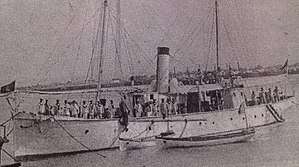NMS Grivița
NMS Grivița was a gunboat of the Romanian Navy, built in 1880. It was the first warship acquired by the Kingdom of Romania after gaining independence in 1878 and the first military ship of the Romanian Black Sea Fleet. Throughout her career, she saw service on both the Black Sea and the Danube during the Second Balkan War and the First World War.
 Grivița in 1913 | |
| Class overview | |
|---|---|
| In commission: | 1880–1919 |
| Completed: | 1 |
| Scrapped: | 1 |
| History | |
| Name: | Grivița |
| Namesake: | Battle of Grivița |
| Ordered: | 1880 |
| Builder: | STT, Austria-Hungary |
| Laid down: | 1880 |
| Launched: | 1880 |
| Completed: | 1880 |
| Commissioned: | 1880 |
| Out of service: | 1919? |
| Fate: | Unknown |
| Service record | |
| Commanders: | Captain Vlădescu Constantin (World War I) |
| Victories: | 1 cargo ship captured |
| General characteristics (as built) | |
| Type: | Gunboat |
| Displacement: |
|
| Length: | 60.5 meters |
| Beam: | 5.2 meters |
| Draft: | 1.8 meters |
| Propulsion: | Steam, 180 hp |
| Speed: | 9 knots (17 km/h; 10 mph) |
| Complement: | 30 |
| Armament: |
|
Description
Grivița was the first warship acquired by Romania after its 1877-1878 war of independence. She was built in 1880 by Stabilimento Tecnico Triestino in Austria-Hungary, being the last warship purchased by Romania before the country's conversion to a Kingdom in 1881. She measured 60.5 meters in length, with a beam of 5.2 meters and a draught of 1.8 meters. She displaced 110 tons standard and 128 tons with a full load of coal, had a crew of 30 men and a top speed of 9 knots, generated by a 180 hp steam engine. She was armed with two 57 mm Nordenfelt guns, two 37 mm 1-pounder guns and two machine guns.[1][2]
Career

Grivița was ordered in 1880, with the main purpose of enforcing Romanian interests at the newly-established Danube Commission, headquartered in the Romanian port town of Sulina.[3] In 1885-1886, she conducted topographic research off Sulina and the northern half of the Romanian coast.[4] Grivița was brought in Romania by the fleet commander itself.[5]
Between 1886 and 1888, NMS Grivița was commanded by commander Sebastian Eustațiu.[5]
The 1913 Second Balkan War found her on the Danube, where she provided artillery support for the Romanian troops crossing into Bulgaria from Corabia.[6]
When Romania entered the First World War on the side of the Allies in late 1916, she was put at the disposal of the Russian Black Sea Fleet, acting as a liaison ship between the Russian and Romanian forces[7] under the command of Captain Vlădescu Constantin.[8] She was later transferred to the Romanian Danube fleet. In the autumn of 1916, she along with a tug and two barges evacuated the Romanian 37 mm and 57 mm coastal artillery guns from Cinghineaua Island, after the latter ended up 6 kilometres (3.7 mi) behind enemy lines.[9] A few months later, she collided with a Russian ship, but was successfully repaired.[10] After Romania resumed hostilities against the Central Powers in the autumn of 1918, she captured a German cargo ship sailing for Odessa.[11] She was mentioned for the last time in March 1919,[12] her ultimate fate being unknown.[13]
See also
- Grivitsa, the location of the Battle of Grivița the ship is named for
References
- Roger Chesneau, N. J. M. Campbell, Conway's All the world Fighting Ships 1906-1921, Mayflower Books, 1979, p. 421
- John Evelyn Moore, Jane's Fighting Ships of World War I, Military Press, 1990, p. 295
- Ştefan Negrea, Pe urmele lui Grigore Antipa, p. 132 (in Romanian)
- Revista muzeelor și monumentelor, Volume 26, p. 47 (in Romanian)
- Fortele Navale Romane (Summer 2010). "MARINA ROMÂNÃ" (PDF). MARINA ROMÂNÃ. 5: 43, 45. Retrieved 10 October 2018.
- Raymond Stănescu, Cristian Crăciunoiu, Marina română în primul război mondial, p. 35 (in Romanian)
- Marea revoluție socialistă din octombrie și mișcarea revoluționară și democratică din România, p. 331 (in Romanian)
- Raymond Stănescu, Cristian Crăciunoiu, Marina română în primul război mondial, p. 271 (in Romanian)
- Raymond Stănescu, Cristian Crăciunoiu, Marina română în primul război mondial, p. 93 (in Romanian)
- Raymond Stănescu, Cristian Crăciunoiu, Marina română în primul război mondial, p. 222 (in Romanian)
- Codreanu Săvoiu, Curierul judiciar 1923, p. 553
- Raymond Stănescu, Cristian Crăciunoiu, Marina română în primul război mondial, p. 271 (in Romanian)
- Roger Chesneau, N. J. M. Campbell, Conway's All the world Fighting Ships 1906-1921, Mayflower Books, 1979, p. 421